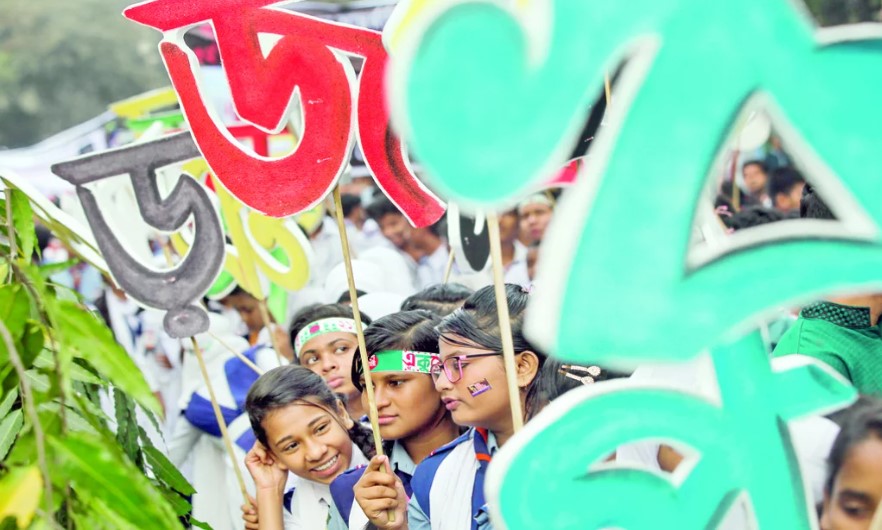February is the time of spring in Bangladesh and 21 February is the red letter day in the nation’s history when a new spring was ushered in 1952 with a number of patriotic youth sacrificing their lives to protect the right of the mother language. The nation, united on their ethno-linguistic identity, established the right of the people for self-determination, and Bangladesh emerged as an independent state in 1971. Since then 21 February or Ekushey, as it is popularly known, has became a day of celebration and reckoning.
In 1952 when the oppressed people of this land raised the demand for recognition of Bangla as a state language of Pakistan, they at the same time also showed respect to Urdu, declared as the only state language. Bangalis were in the majority and Urdu was the mother tongue of less than 10% of the population, nevertheless there was no majoritarian approach, as the demand was to give recognition to Bangla, side by side with Urdu. Such inclusivity and respect to the right of other languages has relevance for today’s world. We are facing linguistic globalization with the spread of a small number of languages all over the world. With the shift in technology, digital communication, economy, trade and culture, linguistic diversity is facing new challenges. All these have made the International Mother Language Day more significant with new dimension and new responsibility.
Ekushey received universal attention and recognition in 1999 when UNESCO declared 21 February as International Mother Language Day to protect and promote the languages of the world. Language is the juice of life, human means of communication, where knowledge systems are deposited and secured. The diversity of language, big or small, forms the republic of languages, but unfortunately in our time we have come to the critical point of losing much of this diversity. It is estimated that there are about 7,000 existing languages and many of them will not survive in this century. The loss of a language is not only a loss for the community to whom the language belongs, but for the entire civilization. Kapila Vatsayan, the cultural activist and scholar has rightly observed, “The disappearance of an individual language constitutes a monumental loss of scientific information, culture, knowledge, historic account of human migration and language evolution.”
The International Mother Language Institute, established by Bangladesh as a Category II institute of UNESCO has conducted an ethno-linguistic survey and found that even in our overwhelmingly mono-linguistic country where about 150 million people have Bengali as their mother tongue, there are 41 other languages in existence. Like elsewhere the richness of linguistic diversity in Bangladesh is also threatened. The survey shows that about 15 of the country’s languages are vulnerable as only from about 50 to 3,000 people speak in that language. These are Soura, Koda, Mundari, Kol, Malto, Kondo, Khumi, Pangkhuya, Chak, Kiyang, Rengmicha, Lusai, Kahria, Deshwali and Laleng/Patra.
International Mother Language Day celebrations around the world, many hosted by Bangladeshi Embassies and High Commissions, are a crucial step in raising awareness of the plight of the many vulnerable languages. The United Nations has also declared the International Decade for Indigenous Languages 2022-2032 to further strengthen awareness of the vulnerabilities of many of the languages that fall into the most vulnerable category.
Moving beyond raising awareness, the next step is to ensure that these languages, whether a national language with millions of speakers or a minority language such as Soura, are documented and transmitted so they will be passed onto future generations.
The research and documentation conducted by the International Mother Language Institute need to be accelerated and deepened to create an archive of the languages of Bangladesh. Such an archive will include information on the languages, the speakers and the cultures. It will include recordings and videos of the languages in practice. It will be a reference source for speakers of each language to draw on in the future, and ultimately it will be a repository for future citizens of Bangladesh.
Transmission needs to be further supported through encouraging story-telling and through education. Story-telling is the most basic and pervasive form of transmission, from a mother to a baby, from grandparents or elders, between children playing. These stories are also the first part of our education. They pass on both language and knowledge. Formalizing this through schooling will accelerate and deepen transmission.
This is not always an easy process. Not every language has a defined script or grammar. The vocabulary may not be adapted to modern situations and hence the line between two languages can be blurred. Solving these obstacles must be part of the solutions for documentation and transmission.
It is an urgent issue. Due to the small number of speakers of many of Bangladesh’s languages, if action is not taken soon, there may be no speakers living in a few years. Some people might say if there is no-one left to speak the language, why do we need to preserve it. Returning to Kapila Vatsayan’s observation, the interconnectedness of culture and language, as well as between languages, makes this a loss to humanity and our knowledge and understanding of culture and history. It is a loss to the community and its identity through its assimilation into the mainstream, a loss that often leads to serious social and economic issues.
Bangladesh is a champion for mother language around the world, so let’s work together to support all of the languages of Bangladesh and ensure that they survive and flourish, along with the communities who speak them.
(Mofidul Hoque is a Trustee of Liberation War Museum and Dr. Susan Vize is the UNESCO Representative to Bangladesh)

